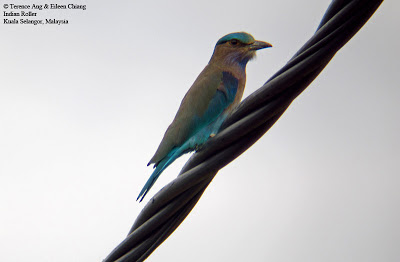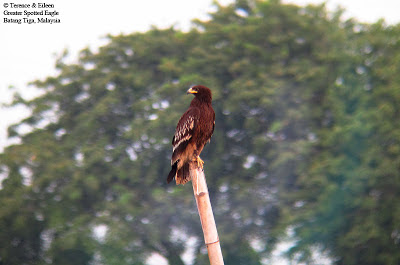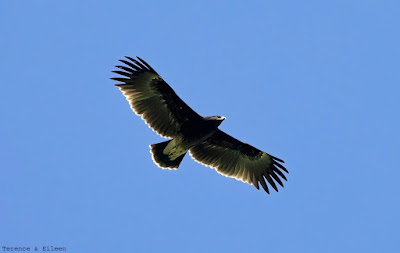Peregrine Falcon Falco peregrinus (Tunstall 1771)
Peregrine Falcon Falco
peregrinus
Other Name: Black-Cheeked Falcon, Duck Falcon, Shaheen
Falcon
Migrant/Resident
Status and
distribution
Regular in Peninsula Malaysia up to 6000 feet asl in Genting
Highland. Resident race from Falco.p.enerstii
have been recorded breeding from Perlis south to Perak but occur south to
Johore. Breeding up to 3000feet asl. This subspecies could also involve in local
migration as well.
Description
Large falcon with dark grey to blackish above and variable
pale white to rufousy below with barring and spotting. Migratory race with
moustached and resident race with full hood and darker above.
In flight, the wing underwing marked blackish. Pointed wing
are distinctive. Immature head patter are rather similar to adult with
upperpart dark brown compare to black. Underpart can be heavily streak compare
to barred of the adult.
Migratory white cheek:
In peninsula Malaysia there is 2 subspecies of white cheek migratory Peregrine
namely the F.p.japonicus and F.p.calidus. Both subspecies show an
extend of white cheek with dark moustached where F.p.japonicus show thicker moustached making the cheek look smaller
omapre to the latter. On upperpart, both species show greyish darker in F.p.japonicus than in F.p.calidus. Most very pale individual
may would have been F.p.calidus. On
the underpart, the F.p.japonicus show
distinctly broken bar on underpart especially on side of breast on white to
pale rusty white body. Remaining part are clearly broken bar. F.p.calidus show more spot where clear
spot can already be noted on the side of breast replacing bar of the F.p.jaonicus on white to pinkish white
body. In flight both underwing show fine dark bar on pale flight feather with
fine barred on wing covert. Juvenile of both subspecies is very similar and can
be doubtfully separate in field. Brownish to dark brown above with pale
forehead. Throat buff and remaining underpart buff with dark streak. Eye ring and
leg yellow, fresh to bluish in juvenile. (Details require further study
including some F.p.calidus at
reast show wing extended slightly below wing compare to F.p.japonicus. This at current time I do not have enough individual for confirmation)
Migratory hooded:
One subspecies where is rarely encountered which is F.p.peregrinator. Fully hooded and entire upperpart dark with
pinkish white throat gradually into rufous on remaining underpart. Barred
variant have dark bar on the rufous underpart and somewhat more spaced out
compare to F.p.enerstii. Unbarred
variant uniform rufous underpart.
Resident: Fully
hooded and entire upperpart dark to blackish. Underpart pale grey gradually
fate into rufous from mid body downwards. Very dense barring below.
Juvenile of F.p.peregrinator
and F.p.enerstii are very similar and
can be doubtfully separate in field. Both show fully hooded and dark streak
below. Heavier in F.p.enerstii and
may show pale rufous in some individual. Mainly white throat suggest to be F.p.peregrinator and barring distance on the under part shall be taken note in separation
of this two subspecies.
Confusion Species
Easily confuse with Oriental Hobby which is much smaller. Note
on hood shape. At rest, Peregrine falcon tail reach tail tip while Oriental
Hobby way pass tail tip.
Geographical
Variation
Falco.p. japonensis and
Falco.p. calidus both were winter
visitor and passage migrant.
Falco.p. enerstii are known resident subspecies. This
species have been observed lowland to highland with record from Kinabalu
National Park, Frasers Hill, Cameroon Highland.
Falco p. peregrinator was rare subspecies. Many
record remain doubtful. Some of the more confirmed recorded were from Fraser’s Hill
and another from Genting Highland. Record were during migratory period
suggesting this species were mainly migratory. N record of this subspecies in
the period of May -September.
Behaviour
Perch on a vantage point to search for food. Majority of
prey consist of green pigeon, bulbul, Black Naped Oriole and wader. One
observation in Penang, a migratory subspecies attempt to hunt a whimbrel. In Teluk
Air Tawar, Penang, it was observed an attempt on a roasting flock of wader.
Other such as attempt on a Little Egret was observed as well suggest they make
take larger prey item. Element of surprise are used in an observation in
Langkawi where as pursuit in many other location.
Majority of the hunting method was observed as soaring
hunter where prey were detected in flight. A few in Taiping, was observed as
perching hunter. The bird was sighted to on perch taking flight and return
within 2 minit time with a prey. The bird was not sighted nearby during the
flight however return with yellow vented bulbul.
Hunting have been observed in area such as high rise
building, open country and forested area however there is no stopping-hunting
have been recorded.
The same record mention by well’s. Perhaps the technique of
hunting require further study in Malaysia.
Habitat
Lime stone, hilly area, lowland to montane forest, mangrove,
mudflat, and open area.
Bird seem to be able to leave in area of housing such as the
record from Taiping.
Breeding
Copulation on late December – February. Incubation started
in first half of February (Well’s 1999)
Photo
Video
Reference
Reference
Ben
F.King & Edwards C.Dickson, 1989, A Field Guide To The Birds of
South-East Asia, Collins, Grafton Street, London
Betram
E.Smythies 2001, The Birds of Burma, Natural History Publication, Kota
Kinabalu (ISBN 983-812-049-9)
Craig
Robson, 2017, A Field Guide To The Birds of South-East Asia,
Bloomsburry, London
Dick
Forsman 1999, The Raptors of Europe and The Middle East, Christopher
Helm, London. (ISBN 978-0-7136-8821-4)
Dick
Forsman 2016, Flight Identification of Raptors of Europe, North Africa and
the Middle East, Christopher Helm, London. (ISBN 978-1-4729-1361-6)
David
R Wells, 1999, Birds of The Thai Malay Peninsula Vol 1, Academic
Press, London UK
James
A. Eaton, Bas van Balen, Nick W. Brickle & Frank E. Rheindt, 2016, Birds
of the Indonesia Archipelago Greater Sundas and Wallacea, Lynx
Edicion, Bercelona
James Fergusan Lee and David A
Christie 2001, Raptors of The World, Christopher Helm, Great Britian
(ISBN 0-618-12762-3)
Pamela C. Rasmussen 2012, Birds
of South Asia, Lynx Edicions, Bercolona (ISBN 978-84-96553-85-9)
Rishad Naoroji 2007, Birds of
Prey of the Indian Subcontinent, OM Book International, New Delhi (ISBN 8187107699)
Salim
Ali & S. Dillon Ripley, 1981, Handbook of the Birds of India
and Pakistan ,Oxford University Press , London








Comments
Post a Comment